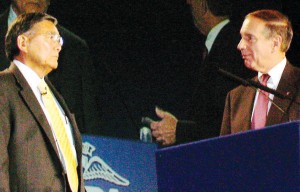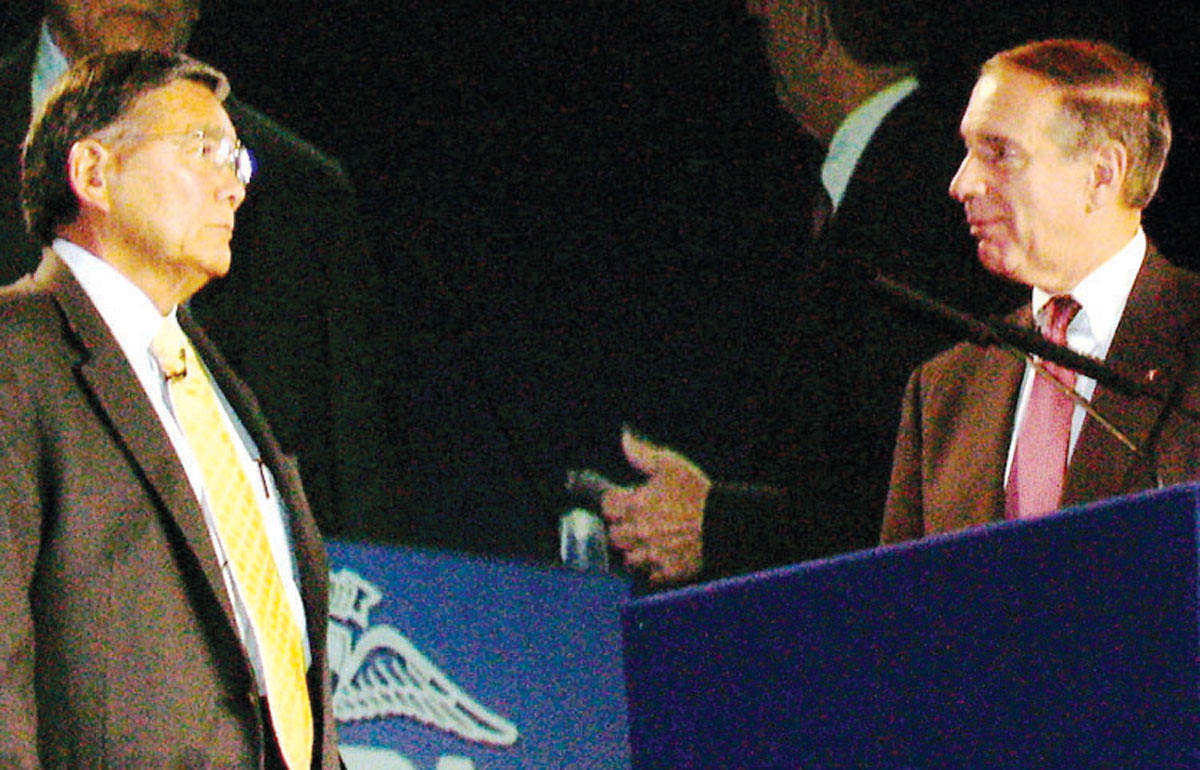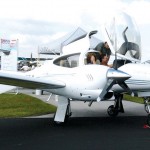By Jack Elliott

Secretary of Transportation Norman Mineta, the guest speaker at the opening general session, listens intently to a question from AOPA President Phil Boyer.
The Aircraft Owners and Pilots Association has an impressive record of defending the rights of the nation’s private pilots, two thirds of whom (407,184) are members. Those who attended AOPA Expo 2005 in Tampa, Fla., November 3-5, went home with a very clear indication of the energy and effectiveness with which AOPA addresses issues that affect general aviation pilots on a daily basis.
At the first general session of the convention, Secretary of Transportation Norman Mineta was the guest speaker. This was the first time that a cabinet level government executive addressed the convention. Mineta received a glowing tribute from AOPA President Phil Boyer in his introduction. The two men have known each other and worked together on aviation issues over a period of many years and they obviously hold each other in high esteem. In 1987, as a member of congress, Mineta received one of AOPA’s highest honors, the Hartranft Award.
Mineta didn’t duck the tough and controversial issues in his appearance before the AOPA members. Chief among these is the issue of user fees, which have been proposed and are strongly opposed by general aviation. The airlines support the proposal because they want to put a bigger share of the financial burden of operating our air transportation system on general aviation. The FAA views it as a good source of achieving more revenue.
Mineta addressed the subject in the question and answer period following his speech. Referring to the search for new sources of funding, Mineta said, “From my perspective, it will not be a user fee.”
He pointed out that this would compromise safety because it would discourage pilots from filing flight plans and using Flight Service Stations. He said he wanted to see safety increased rather than decreased and he would continue to fight for a fuel tax as a source of funding.
Another announcement of some consequence that Mineta made was that he was extending the comment period on the proposal to make the Washington ADIZ permanent by 90 days. He said that 18,000 responses had been received.
In closing the session, Boyer asked Mineta his feelings about the future of general aviation. Mineta replied that he was optimistic about GA and looked forward to a great future for general aviation.
The AOPA Expo provides a fountain of information to members. The three general sessions that opened each day’s proceedings were only one source of important information. There was a vast variety of seminars on subjects of vital interest to pilots. There was great interest in sessions on the latest technological advances, particularly the use of GPS and glass cockpits.
Another popular attraction was Rod Machado, who laces his how-to flying talks with a rare brand of humor that brings people flocking back to hear him every year. This year the humorist was also a luncheon speaker.
There were seminars on every conceivable subject of interest to pilots, including flying to Mexico, weather, Wide Area Augmentation System, and concerns of owners such as flying clubs and shared ownership, as well as medical concerns including vision and recertification, and safety issues.
Another source of information and education is the exhibit hall. While there are hundreds of items for sale and no shortage of attractive show specials, there was also the opportunity to get some hands-on experience with GPS units and with a variety of simulator models.
The static display
Another significant part of this event was the static display at Peter O. Knight Field, a beautiful GA airport not far from the convention hall. New general aviation airplanes are popping up like crocuses in the spring and here is where you can see them all in one place at one time. Many of the aircraft on display are models that most pilots have never seen before. There were 103 aircraft on static display.

The centerpiece of the static exhibit at Peter O. Knight Airport, a completely restored Commander 112 boasting a glass panel, will be given away in a drawing next year.
One of these was the Diamond DA42 Twin Star, an Austrian built twin diesel that is assembled in London, Ontario. The aircraft, which was certificated last summer, has a cruising speed of 172 knots at 80 percent power, burning a total of 12.5 gallons an hour. It boasts the one lever throttle Full Authority Digital Engine Control that automatically adjusts the mixture. There are 200 orders for the aircraft in the U.S. The price tag is $460,000 without deicing, oxygen or air conditioning.
The Velocity, a four-place, composite homebuilt that resembles Burt Rutan’s Vari-Eze and LongEze, was another aircraft on display that most pilots have never seen, even though 700 kits have been sold. Only a relatively small percentage of them are flying. The cruising speed of this aircraft ranges from 160 knots to 205 knots at 75 percent power, depending on what engine is installed. The engines range from 160 hp to 310 hp. Kit prices range from $78,950 with a mid-time engine to $83,304 with a new 310-hp Continental.
Kits are produced at Merrill Island, Fla., for the Comp Air 8, an eight-place homebuilt (six adult and two children) on display, which lists for $82,495. The first sale took place in 1994, when it was a piston aircraft. In 1998 the company put a turboprop engine in it. There are nine versions of Comp Air aircraft ranging from a two-place tube-and-fabric model with a Rotax engine (the Merlin II) at $30,795, up to the Comp Air 10, an eight- to 11-place version priced at $93,495.
Another eight-place aircraft in the static exhibit was the Australian GA-8 Airvan. Twenty of these aircraft have been sold in the U.S., 16 of them to the Civil Air Patrol. Grippsland Aeronautics, which produces the Airvan, started in 1979 as a maintenance organization. They have built 90 aircraft and are now producing one every eight days. The aircraft was certified in Australia to FAR Part 23 standards and received its FAA certification in 2003. Powered by a 300-hp Lycoming IO-540-K, it sells for $490,000 with avionics.
Canada is in the eight-place market also with the Bush Hawk XP. Certified in 2001, 200 have been sold, including 27 in the United States (most of them in Alaska). Ninety percent of the aircraft are on floats. Like the Australian Airvan, a 300-hp IO-540 engine powers it. It lists for $359,500 with avionics.
There was one aircraft on display that everyone has seen, but this was actually the son or maybe grandson of the original. This is probably the world’s best known aircraft, the Piper Cub. Cubcrafters of Yakima, Wash., which has been rebuilding Cubs for 25 years, has brought it back to life–in two versions. The Top Cub is a version of the original, built under a brand new FAR Part 23 type certificate, and the other is a light sport aircraft version.
The Top Cub has a 180-hp Lycoming engine–three times the horsepower of most of the originals–and the Sport Cub has a 100-hp Lycoming. The price of the Sport Cub is $99,500. Sixty have been sold. The Top Cub sells for $159,000 without avionics.
The closing session
At the final general session of the convention, Phil Boyer traditionally introduces the top members of his executive team and gives them an opportunity to discuss the work being done by their departments. Boyer prefaced the introductions by reading a few of the letters opposing the proposition to make the Washington, D.C. ADIZ permanent. One was from an Iraq veteran who wrote that he had given a year of his life defending the freedom that the ADIZ takes away.
The parade of executives introduced by Boyer was led by Bruce Landsberg, director of the AOPA Air Safety Foundation. Landsberg, one of the nation’s foremost leaders in promoting flying safety, reported that accidents were down seven percent for the year and fatal accidents down five percent.

The Velocity, a four-place, composite homebuilt aircraft resembling Burt Rutan’s Vari-Eze design cruises at 200 mph.
Andy Cebula, senior vice president of government and technical affairs, reported that the transfer of the FSS operations on October 4 from the FAA to Lockheed Martin had brought little change and in some cases has brought improvement. Hold times were down and so were lost calls (instances where callers eventually hung up because they couldn’t get through). He emphasized that these operations are still under the supervision of the FAA. The transfer was designed to cut FAA’s operating costs.
Karen Gephart, senior vice president of products and services, said there’s no evidence that older pilots, a growing segment of the pilot population, were less safe than younger pilots, and consequently there’s no basis for higher insurance rates on older pilots.
As a fitting end to the event, Boyer surprised two members of this executive team, Cebula and Gephart, by promoting both of them on stage to the position of executive vice president.
Tribute was paid to Phil Boyer for his 15 years of service as president of AOPA. During that period, Boyer has assembled a group of people of the highest caliber who are dedicated, hard-working and know how to achieve results.
- The twin-diesel Diamond DA42, built in Austria and assembled in Canada, burns a total of 12.5 gallons at 80 percent power, which gives it a speed of 172 KTAS.
- Kits for the Comp Air 8 composite homebuilt turbines are built in Merrill Island, Fla.
- Patty Wagstaff greets pilots under the Cirrus canopy.
- This 180-hp Top Cub, by Cubcrafters of Yakima, Wash., is similar to the original Cub, but has far greater power.
- Erik Lindbergh talks flying with fans.
















